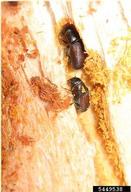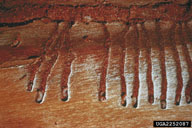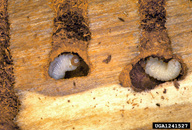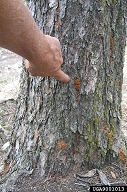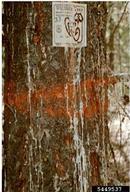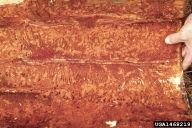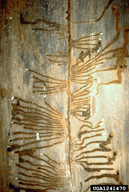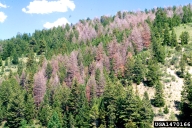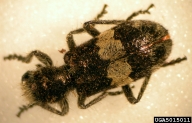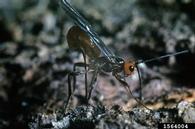Douglas-fir beetle
Dendroctonus pseudotsugae Hopkins (Coleoptera: Curculionidae, Scolytinae)
Orientation to pest
Douglas-fir beetle, Dendroctonus pseudotsugae Hopkins, a native North American bark beetle, is the most important pest of Douglas-fir (Pseudotsuga menziesii [Mirbel] Franco) in western North America and the only bark beetle attacking this important timber species. Like many bark beetles, this species often persists at low levels, breeding primarily in felled, injured or diseased trees and doing little damage to any particular stand. However, at times populations develop that are able to kill even healthy trees, over large areas. Such outbreaks may develop after extensive wind damage, droughts, or large fires that greatly increase the number of susceptible trees. The signs of this bark beetle include reddish or yellowish boring dust caught in bark crevices. Live trees may respond to attack with abundant resin flow. A male and female beetle work together to dig an oviposition gallery, where the female lays her eggs, which are deposited in groups (10-36), spaced out at intervals along the oviposition gallery. Larval dig feeding galleries that diverge from the oviposition gallery in groups that resemble fans. Larvae pupate in cells constructed at the ends of the larval galleries. The Douglas-fir beetle has one generation per year. The insect mostly overwinters as adults, but with some large larvae present as well. Adult emergence from the wood occurs from April to June, depending on location and altitude, and newly emerged beetles attack new trees in July and August. In coastal areas, host tree resistance is usually adequate to check population growth of this species. But in inland areas, where trees are subject to greater environmental stress, outbreaks are more common.
Hosts commonly attacked
The only breeding host of this beetle is Douglas fir (P. menziesii).
Distribution
Douglas-fir beetle is found throughout the range of its principal host in the western United States, Mexico and Canada.
Images of Douglas-fir beetle
| Figure 1. Pair of adult Douglas-fir beetles, Dendroctonus pseudotsugae, inside gallery | Figure 2. Larvae of Douglas-fir beetle in their galleries | Figure 3. Red boring dust (left) and resin flow (right) on the bark of a Douglas-fir produced by adult Douglas-fir beetles |
| Figure 5. Douglas-fir killed by Douglas-fir beetle | Figure 6. Adult of Enoclerus sphegeus Fabricus | |
| Figure 4. Galleries of Douglas-fir beetles | Figure 7. The braconid parasitoid, Coeloides vancouverensis (Dalla Torre), ovipositing through shaved Douglas-fir bark onto Douglas-fir beetle larvae. | |
Important biological control agents related to this pest species
Among the important natural enemies of the Douglas-fir beetle are Enoclerus sphegeus Fabricius, Thanasimus undatulus Say, Temnochila chlorodia Mannerheim, Coeloides brunneri Viereck, and Medetera aldrichii Wheeler.
Web links for information on Douglas-fir beetle
- Fact Sheet and Management Guide from FETCH 21 | University of British Columbia
- Forest Insect & Disease Leaflet 5 | USDA Forest Service
Articles
- Furniss, M. M. 1979. An annotated bibliography of the Douglas-fir beetle (Dendroctonus pseudotsugae Hopkins). USDA Forest Service General Technical Report (INT-48), 40 pp.
